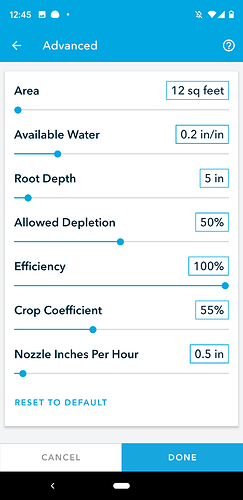Okay, this is my first post in the community. To explain my situation, I have some seriously bi-polar soil, pretty sure it is clay (zip code 94803, zone 10b(?). The soil has been tilled and amended (about 10-12in.) with garden soil and has been mixed for about 3-4 weeks (much softer that previous). When planting the plants this past Thursday, I further mixed the soil with potting soil. Mixed it all up just to give the plants a good bed to lay on. I have planted 2 different types of plants; Sisyrinchium bellum (12 individual plants in a combined space of about 12 sqft, and Cordyline Design-a-line Burgundy (7 individual plants in a combined space of about 31 sqft. I have my irritating separated into 2 zones. Clearly 1 zone per plant type. I an doing drip irrigation, using a .5 galph emitter on every plant. I want to maximize watering efficiency, and so I am trying to adjust the advanced settings. I am totally lost. Even as far as the type of soil to say that I have. I don’t know if the AREA is smaller because I am doing drip, vs sprinkler? Can someone please help me. Unfortunately, I kind of need directions on each of the advanced settings:
AREA
AVAILABLE WATER
ROOT DEPTH
ALLOWED DEPLETION
EFFICIENCY
CROP COEFFICIENT
NOZZLE INCHES PER HOUR
Any help, or support given is appreciated
Your advanced settings show a nozzle output of 0.5 inches per hour.
Check out this easy-to-use link from Washington State University.
https://www.google.com/url?sa=t&source=web&rct=j&url=http://irrigation.wsu.edu/Content/Calculators/Drip/Drip-Line-Rate.php&ved=2ahUKEwirsKXeopnlAhVBIqwKHc7ZCmQQFjACegQIBRAB&usg=AOvVaw0IzW1l7A0Jto536UrhEP6D&cshid=1570971014385.
I have not heard of the plants you mention. If you have incorporated organic matter into clay soil, why not try clay loam. Depending on the mature depth of roots of plants, once the water goes below the mixed soil, it will hit the clay and just sit there. Water intake if clay soil is about .15 inch per hour, where your drip in inches is putting out 0.8 inch per hour. I did not answer all your questions, but I hope I helped. You will enjoy Rachio once you get everything going.
Thank you for the feedback. I will definitely put look into it.
@robertokc – that’s a nice website!
@KJones7440 – I think that the Water Application Rate Calculator at the Washington State University website might be something else to look at especially if your drip is not installed as a grid but as an emitter at each plant with some random spacing.
First though, the area setting on Rachio is only used to estimate water usage. That value will not impact how the plants are watered. HOWEVER, for drip, you do want to know the estimated area that needs to be watered on an individual plant basis (more in next paragraph). Root depth is important but Rachio’s defaults for annuals should be a good start. You can estimate this based on the depth of the pot the plants came in and maybe add a couple inches more or Google for the average root depth of those plants. Crop coefficient is important but it is harder to get that information especially for non-food crops. The rachio defaults for crop coefficient will probably be the best place to start and if the plants seem to need more water, add 5%-10%. If they seem overwatered, subtract 5%-10% from the crop coefficient. You’ll want to monitor and adjust until your plants seem happy. I would not change allowed depletion, that’s pretty standard. So that brings us to Nozzles Inches Per Hour, the most critical part.
If using the Water Application Rate Calculator to calculate Nozzle Inches Per Hour, you’ll need to choose whether to use the average area of all plants on the drip or only use the area of the most (or least) water hungry plant or the area of a representative plant. To get at watered area, you’d measure the radius from plant stem to its outer leaves, then use pi*radius^2 to get area of that plant. You could do this for each plant and then average the areas – do not use the area for the entire planting bed. You want only (roughly) the area of roots you need to watered. The nozzle rate is going to be necessarily calculated for a single emitter rate, so you’ve made it easy on yourself by selecting only 0.5 GPH for all plants. Excellent! The Water Application Rate calculator is very flexible with all kinds of units available – so you if you measure the radius in inches, be sure to select inches^2 for the resulting area. Then enter in your 0.5 GPH and select GPH. Does this make sense?
So a representative single plant may have a 6" radius from stem to the where the leaves end. So pi*6^2=113 in^2 or 113 square inches for a single plant. Enter that value into the calculator, being sure to select square inches as the area unit. At 0.5 GPH, the calculator says 1.02 in/hr for that representative plant. If on average plants on that drip line have about 6" radius, then the 1in/hr would a good choice for all plants. As the plants grow, you could recalculate the nozzle inches/hour by remeasuring the plant radiuses. Once they’re mature, you won’t have to adjust as much (hopefully).
For new plants fresh out of the pot, you may just want to use the surface radius of the rootball.
1 Like

